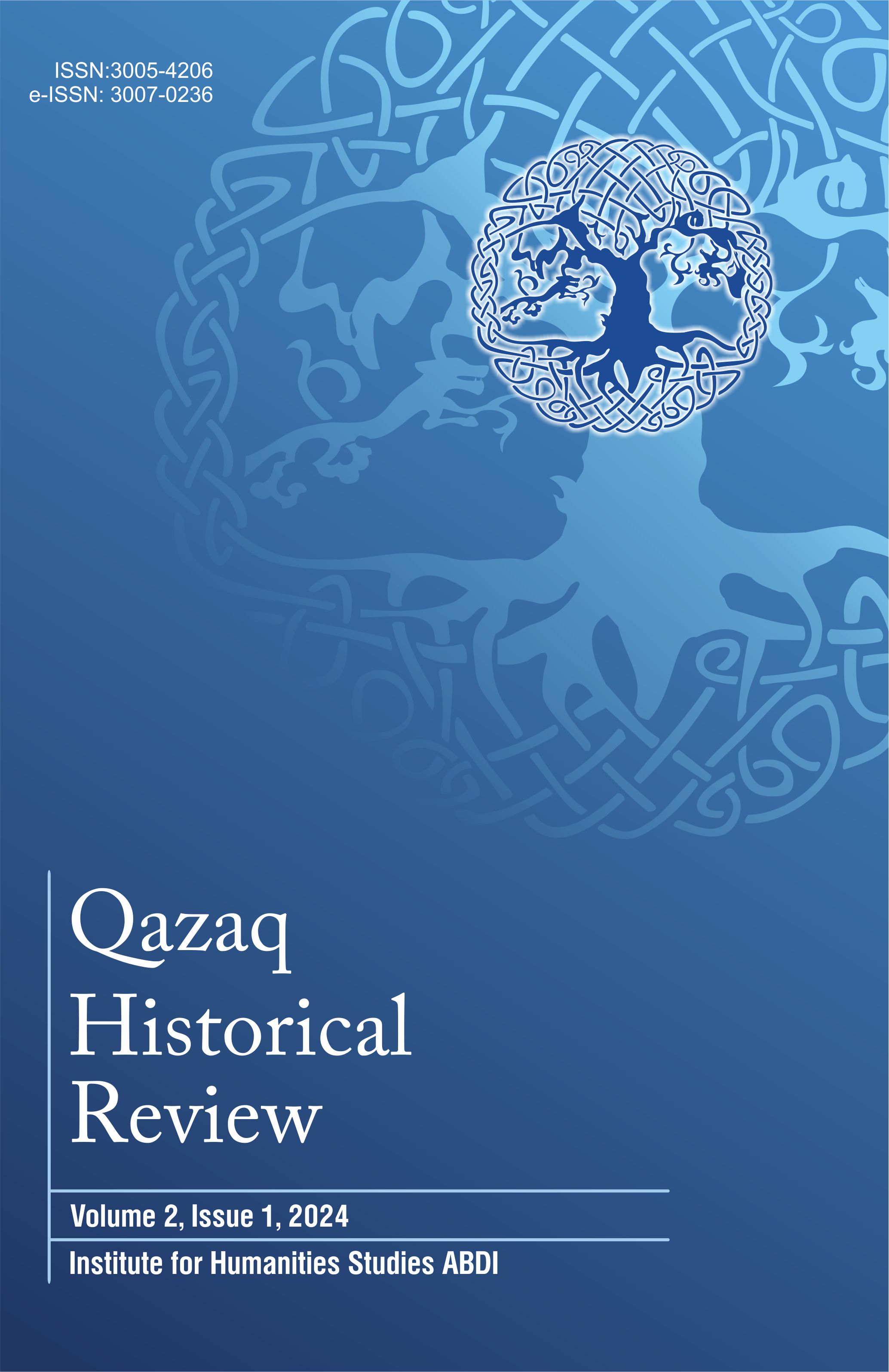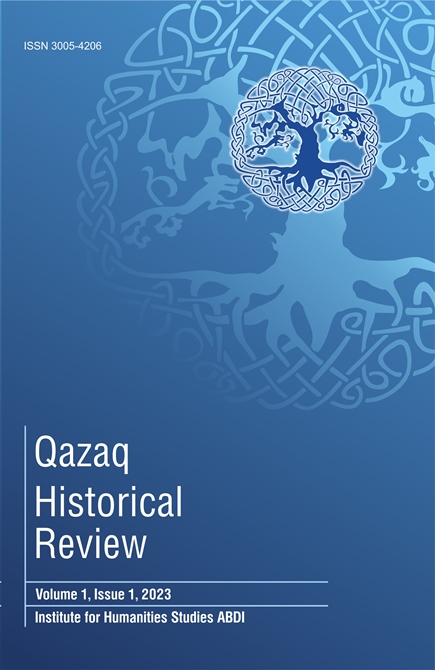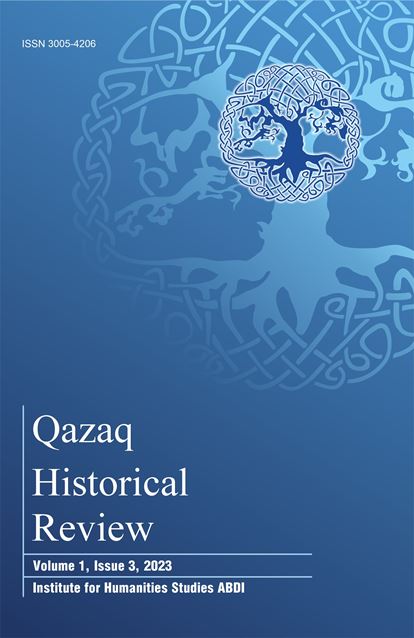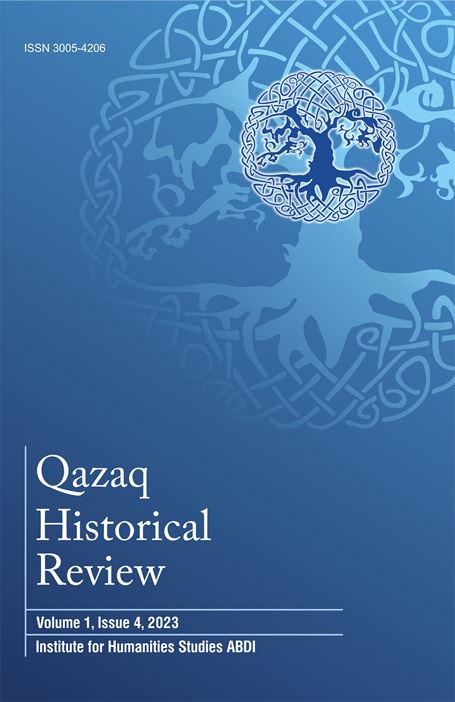Archives
-

Vol. 2 No. 1 (2024)
The images of Qazaqstan's distant past never cease to arouse interest. Ruins of ancient settlements and majestic burial mounds, centers of ancient metallurgy and religious settlements, ancient tools, ceramics or coins, all this has a strong emotional impact. The study of the archaeological heritage of Qazaqstan in Soviet times and during the sovereign period has significantly expanded the horizons of national history, proved the existence of ancient and developed archaeological cultures, and their global connection with the most ancient centers of human civilization.
Modern representation of archaeological discoveries in museums and school textbooks, modern monuments and symbols of the state testify to the importance of the ancient period in our days. Sometimes the past is incorrectly, or biasedly interpreted and non-existent sensations or fantastic phenomena are ‘found’ in it. To neutralize all this, archaeologists of Qazaqstan not only conduct scientific research, but also conduct an active dialogue with society, explaining in simple language the goals and methods of complex archaeological research.
The current issue of the scholarly journal Qazaq Historical Review is devoted to the current results of archaeological research. The editorial board has invited modern Qazaqstani archaeologists as authors to publish the results of their research. We hope that the new published material will help in further research.
Antonina Ermolaeva, Albina Erzhanova, and Ekaterina Dubyagina – a Margulan Institute of Archaeology team, are publishing new data from the ancient metallurgy monument in the Zhezkazgan-Ulytau mining and metallurgical center, the Taldysay Settlement. Tatyana Loshakova, Senior researcher at the Institute of Archaeology, is presenting the results of research of the Bronze Age settlements (Toksanbay, Aitman and Manaysor) on the Ustyurt plateau in the North-Eastern Caspian region, against a broad historical and archaeological background. Ilyar Kamaltdinov's article is examining a medieval bowl from the 10th – 11th centuries with an image of a steppe eagle and epigraphic decor, found during excavations in the northern part of the shakhristan of the medieval settlement of Otrar. Asemgul Kasenova, Candidate of History, Leading researcher at the Institute of Archaeology, is tracing the history of chamber sculptures of Central Qazaqstan, and their modern study. Zhanbolat Utubaev and Sergey Bolelov, both Candidate of History, have devoted their article to the history of the formation and development of the ancient delta of the Syr Darya and its settlement before the beginning of the 1st millennium AD, according to archaeological data. Dokey Taleev, Candidate of History, Leading researcher of the Institute of Archaeology, is reconstructing the sacred meaning of the Golden Horde cities of Saraychik and Barchinkent.
The special editor of the issue is Asemgul Kasenova, a Candidate of History.
-

Vol. 1 No. 1 (2023)
The past decade in Kazakhstan was marked by a noticeable interest of researchers and the general public in the history of the Kazakh statehood of the late Middle Ages. Considerable attention was paid to the information of ancient maps about the medieval Kazakh state. Along with scientific research on medieval cartography, not always objective publications appeared, and that is why the thematic block of the first issue is devoted to this topical topic. In this regard, the editorial board and the staff of the ABDI Institute for Humanitarian Studies unanimously decided to devote No. 1 2023 of the journal "Qazaq Historical Review" to the problems of historical cartography of Kazakhstan, Central Asia and the whole of Eurasia. The Editorial Board invited leading modern historians, geographers, ethnographers as authors to publish the results of their scientific research. We hope that the new published material will set the right scientific direction for the development of historical, geographical and cartographic science in Kazakhstan.
We tried to give the cards in good digital quality and accompanied them with a QR code. Using the camera of a mobile device, you can scan it and get access to a high-quality image.
The publication by Galina N. Ksenzhik and Erlan T. Karin is devoted to the analysis of the consolidated catalog of Russian cartographic materials of the XVII – early XX centuries on the history of Kazakhstan.
A significant part of the issue is devoted to the medieval cartographic thought of Europe about Central Asia and, in particular, the wonderful maps of Anthony (Antonio) Jenkinson's. Svetlana M. Gorshenina, professor at the National Center for Scientific Research of France, analyzes a new cartographic scheme of Central Asia of the XVI century, proposed by Jenkinson. In particular, the author of the article interprets the Chinese Lake known from his maps as the Aral Sea.
Dr. Nurlan Kenzheakhmet in his article suggests that this lake corresponds to the modern Teletskoye Lake. In his article, the information of European maps about the Kazakh steppe and Central Asia is studied in detail.
The first part of the article by Kazakh ethnographer, chief researcher of the Institute of Humanitarian Studies ABDI Rashid S. Kukashev is also dedicated to the newly discovered "Wroclaw" map of Jenkinson.
Researcher of the Astana MNC, Candidate of Geographical Sciences Sergey V. Rasskazov describes the results of his research and provide copies of unique Russian historical maps of the XVIII – early XIX century.
-

Vol. 1 No. 2 (2023)
The modern political culture of Kazakhstan is the experience of interaction of Qazaq society with neighboring peoples and states that lasted for many centuries. The most important stage in its formation was the period of the second half of the 18th – the beginning of the 20th centuries, when the Qazaq Steppe became the object of Russian imperial expansion and entered active international relations with the Qing Empire and the Central Asian khanates. It is important to understand which political features of Qazaq society were formed due to the conditions of such frontier interaction, further colonization, conquest and integration of the Qazaqs into the Russian imperial space, the subsequent waves of immigrants, and the final loss of political independence. The events and processes of this period of Qazaq history were one of the many factors determining the new political order. To understand them helps to find some answers to modern challenges.
In this regard, the editorial board of the scholarly magazine “Qazaq Historical Review” and the team of the ABDI Institute for Humanities Studies has focused on the transformation of Qazaq political culture in the second half of the 18th – early 20th centuries as the theme of the next issue (No.2, 2003). The editorial board has invited the leading modern historians to publish the results of their research. We hope that the new publications will be helpful for our readers and specialists.
Articles by Maral A. Satenova and Rashid E. Orazov trace the new political realities for the Qazaqs of the Senior and Middle Zhuzes, their interaction with Russia and China, and the struggle against increasing colonization. Historians Gulfira E. Otepova, Pavel S. Shablei, and Gulmira S. Sultangalieva analyze changes in the politics and culture of Qazaq society, and their reflection in books and newspapers. Dr. Gzavier Allez addresses the topic of integration of the Qazaq elite into the colonial structure of Russian Empire. An important historical document from one of the Russian archives about the peculiarities of the production of Qazaq gunpowder is published and commented by Vladimir T. Tepkeev. Professor Svetlana I. Kovalskaya reviews a new study on the historical cartography of the Qazaq Steppe in the 17th – the beginning of the 20th centuries in the section “Critics and Bibliography”.
-

Vol. 1 No. 3 (2023)
In the field of historical policy in Qazaqstan in recent years, the studies of the tragic pages of the Soviet past and the influence of the dramatic events of those years on the fate of the Qazaqs occupy a special place. The political leadership of Qazaqstan speaks of the need for an objective study of the past by qualified specialists. Much attention is paid to the problems of the 1930s famine among the Qazaqs, repression, and forced deportation of peoples to Qazaqstan. According to the head of state, Kassym-Jomart Tokayev, a restrained and responsible approach from a verified scientific position, without loud slogans and populism, will contribute to an objective assessment of the tragedy of the mass famine of the Qazaq people. For more than three years (2020–2024), the State Commission for the complete rehabilitation of victims of political repression of the 1920–1950s has been working in Qazaqstan. It has carried out extensive research work, opened more than 2.6 million documents and materials, and rehabilitated more than 311 thousand victims of political repression. Historians and archivists in Qazaqstan continue their work in this direction. Taking all this into account, the editorial board of the scholarly journal “Qazaq Historical Review” and the team of the ABDI Institute for Humanities Studies have devoted the current issue (2023, 3) to the history of famine, repression, and deportation of peoples in the Soviet Union. The editorial board has invited leading modern historians to publish the results of their research and hopes that the newly published material will help specialists in further research.
Qazaq historian Aliya Bolatkhan considers the history of Kalmyk “special settlers” in the Alma-Ata region of the Qazaq SSR from 1944 to 1953 as a special group that had confirmed its “Sovietness.” Articles by Natalia Kuzovova and Svetlana Smagulova analyze the severe consequences of famine in Ukraine and Qazaqstan among ethnic minorities and children. Professor Turganbek Allaniyazov analyzes the review reports of the KGB of the Qazaq SSR on the armed uprisings of 1929–1931. German historian Professor Victor Dönninghaus explores the tragic pages of the mass emigration of the German population from the Soviet Union in the late 1920s to Europe and America, called “American fever." The young Belarusian historian Kiryl Latyshau summarized information from post-Soviet historiography about the Bukhtarma Old Believers, who, under conditions of Soviet repression, tried to preserve their identity and traditionalism. The article by Yulia Prostakova is devoted to the problem of representing the image of the “West” in the periodical press of the Soviet Union in the second half of the 1950s and 1960s. Professor Albina Zhanbossinova, tells the story of the tragic fate of three generations of the Aldiyarov family, who found themselves at the epicenter of the socio-political events of the 1920s–1950s, based on archival documents,
The special editor of the issue is Albina Zhanbossinova, a Doctor of History and Professor of the Lev Gumilyov Eurasian National University.
-

Vol. 1 No. 4 (2023)
In its search for new guidelines for the emerging identity and national idea, modern Qazaqstan increasingly appeals to the experience of its medieval history. This direction becomes relevant and socially significant in new historical narratives dedicated to the process of cognition of the historical past. The legacy of the Golden Horde and its influence on Qazaq history and statehood occupy a particularly important place in the new national history writing. Public consciousness forms a stereotype about the deliberate distortion of the “true history” of the Golden Horde in previous eras and especially during the Soviet period. This makes it necessary for a modern rethinking of this stage of national history. This rethinking is embodied in the organization of anniversary events on a national scale, dedicated to the 750th anniversary of the Golden Horde (Ulugh Ulus) in 2019 and the 800th anniversary of the formation of the ulus of Jochi in 2024. According to the country’s president, Kassym-Jomart Tokayev, the Qazaq people are the direct heirs of the Golden Horde, which constitutes an important link in the cultural code of the Qazaqs. Such anniversary events are designed not only to consolidate society, but they should contribute to more in-depth scholarly research and the formation of academic traditions. Rational scholarly cognition of the past, free from ideology and myth-making, is the most important condition for an objective study of this past. Also, world scholarly experience in studying the history of the Golden Horde and the entire medieval period is important. Based on this, the editorial board of the academic journal “Qazaq Historical Review” and the team of the Institute for Humanitarian Research ABDI dedicated the current issue (4, 2023) to new research in the history, source study and historiography of the medieval history of Qazaqstan and Eurasia. Leading modern historians from Qazaqstan, Canada, the Russian Federation, the United States of America, Ukraine, Finland and Japan are invited as authors. Qazaq historian Nurlan Atygayev explores the features of Qazaq-Qalmaq relations in the 16th century. An article by Moscow professor Alexander Kadyrbaev outlines a broad panorama of events during the era of the “Great Migration of Peoples.” Ukrainian researcher Vladyslav Gulevych reconstructs the history of the little-known and mysterious embassy of the Golden Horde’s Khan, Mengu Timur, to the Bohemian king Přemysl II Otakar. Canadian historian, Dr. Joo-Yup Lee, continues to study the Qazaqlïq phenomenon. Qazaq-American professor Uli Schamiloglu shows the impact of the bubonic plague epidemic, known as the “Black Death,” on the political crisis in the Golden Horde. The “Publications” section contains new annotated translations of sources from Latin (article by Roman Hautala), Persian (article by Hiroyuki Nagamine) and Turkish (article by Ilias Mustakimov and Qanat Uskenbay) languages. The issue ends with a review of two new books by Joo-Yup Lee and Marie Favereau



